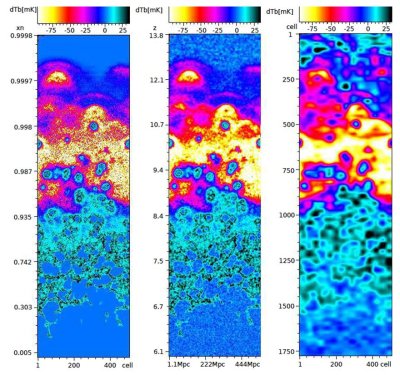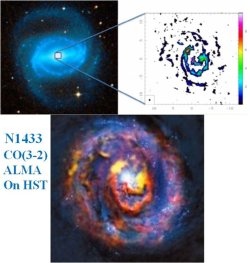Galaxies and Cosmology
Publié le 8 juillet 2014 par .
This pole has several themes of research, which can be gathered in :
- The early universe : inflation, cosmic backgrounds, reionization
- Dark matter : Cold, warm or modified gravity ?
- Galaxy formation : high-z early galaxies, secular evolution and mergers
- Black holes and galaxies : AGN, starbursts, symbiotic growth and feedback
- Star formation efficiency, history and stellar populations
See Activities of the group for more details
The pole Galaxies and Cosmology includes a group working on the cosmic microwave background (CMB), who has a major role in the Planck mission, another group working on the standard model of the Universe, the inflation theory compared to observations. Another team studies through numerical simulations the epoch of reionization of the Universe (EoR, cf Fig 1), and in particular the preparation of SKA (Embrace prototype, key projects on pathfinders, etc..). Pioneering work has been done on cooling flows and the presence of cold molecular gas near the brightest cluster galaxies. The nature of dark matter, and investigation on alternative theories of modified gravity have been probed through galaxy dynamics and observations. A thorough study of AGN fueling and feedback has been carried out, addressing black hole growth history and galaxy evolution.

Another team works both on the observation of local galaxies, the physics of galaxies in clusters, galaxies at high redshift (cf Fig 2), and on the dynamical theories for the evolution and formation of galaxies, on large-scale star formation and the cosmic star formation history.
Multi-wavelengths observations are used extensively, in the millimeter and centimeter with the instruments of IRAM, the VLA and now ALMA since 2011-12, infrared and far-infrared with the satellites Spitzer and Herschel, optical and near-infrared with the CFHT and ESO. Team members are leaders in key programs, such as the NUGA consortium on the IRAM interferometer, the consortium PrimGal on the VLT, or major programs at IRAM (which will be completed by NOEMA in the near future) on distant galaxies, and the observation of galaxies at large z with APEX, Plateau de Bure and ALMA, which data are now frequently arriving to the various groups. One group is actively preparing for the SKA.

One specialty of the pole is also heavy numerical simulations, and the team competed at a very high level in the HORIZON project program of formation of galaxies in a cosmological context. Always larger and more impressive simulations are now going on with the supercomputers at GENCI (Curie at CEA, IDRIS, CINES), and locally use of the meso-center and local momentum cluster is favoring the exploitation and post-processing.





